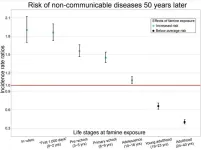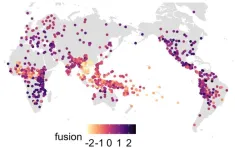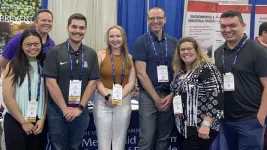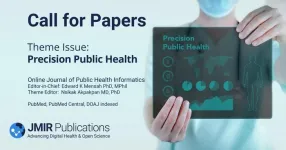(Press-News.org) Researchers at Rutgers and Emory University are gaining insights into how schizophrenia develops by studying the strongest-known genetic risk factor.
When a small portion of Chromosome 3 is missing – known as 3q29 deletion syndrome – it increases the risk for schizophrenia by about 40 fold. Researchers have now analyzed overlapping patterns of altered gene activity in two models of 3q29 deletion syndrome, including mice where the deletion has been engineered in using CRIPSR, and human brain organoids, or three-dimensional tissue cultures used to study disease. These two systems both exhibit impaired mitochondrial function. This dysfunction can cause energy shortfalls in the brain and result in psychiatric symptoms and disorders.
“Our data give strong support to the hypothesis that mitochondrial dysregulation is a contributor to the development of schizophrenia,” said Jennifer Mulle, associate professor of psychiatry, neuroscience and cell biology at Rutgers Robert Wood Johnson Medical School and a co-senior author of the study published in Science Advances. “The interplay between mitochondrial dynamics and neuronal maturation is an important area for additional detailed and rigorous study.”
Mulle, a member of the Center for Advanced Biotechnology and Medicine at Rutgers, and colleagues first showed that 3q29 deletion was a risk factor for schizophrenia in 2010. The findings converge with work on another genetic risk factor for schizophrenia, 22q11 deletion syndrome (or DiGeorge syndrome), which has also been found to involve disrupted mitochondrial function.
“For genetic variants associated with schizophrenia, we want to understand the primary pathology at the cellular level,” said Ryan Purcell, assistant professor of cell biology at Emory University School of Medicine and co-lead author of the study. “This gives us a foothold, which may help cut through schizophrenia’s polygenic complexity and better understand the neurobiology.”
About one in 30,000 people are born with 3q29 deletion syndrome. In addition to increasing the risk for schizophrenia, 3q29 deletion can include intellectual disability, autism spectrum disorder and congenital heart defects. The effect of 3q29 deletion on schizophrenia risk is more than any single known gene variant, but the contributions of individual genes within the deletion are still being unraveled.
The finding that various schizophrenia-associated chromosomal deletions impair mitochondria runs counter to an expectation in the field that such mutations should alter proteins in the synapses that connect neurons. However, mitochondria are critical for energy-hungry synapses’ function – so these models may not be in conflict.
It was also surprising that 3q29 cells have poorly functioning mitochondria because only one of the 22 genes in the deletion appears to encode a protein located in mitochondria. However, that gene or others within the interval may instead regulate the production or importation of mitochondrial proteins, the researchers said.
Mitochondria, which are found in every cell, produce energy from sugar or fat. Sometimes this process is aerobic (done with extra oxygen from inhaled air) and sometimes anaerobic (done without oxygen).
As a result of altered mitochondrial function, 3q29 cells lack metabolic flexibility, meaning their mitochondria have difficulty adapting to changes in sources of energy. This may interfere with neuronal development because maturing neurons need to switch to relying on aerobic energy production as they differentiate.
The results illustrate how 3q29 deletion affects the whole body, not just the brain: The effects on mitochondria are seen in kidney cells as well as in brain cells. Individuals with 3q29 deletion syndrome also tend to be smaller in size, possibly because of altered fat metabolism.
“Eventually, we want to understand which cellular changes like these are linked to specific clinical outcomes, which could help in designing more effective therapeutic strategies,” Purcell said.
END
Schizophrenia genetic risk factor impairs mitochondrial function
Rutgers researcher discovers possible link of mitochondrial function to the development of schizophrenia
2023-08-16
ELSE PRESS RELEASES FROM THIS DATE:
Greater excess mortality after hurricanes more recently and for most socially vulnerable in the U.S.
2023-08-16
Over recent decades, there was a large variation in cyclone-related excess deaths by hurricane, state, county, year, and social vulnerability for counties in the United States, with 83 percent of hurricane-related deaths occurring more recently and 94 percent in more socially vulnerable counties. Results of a study by researchers at Columbia University Mailman School of Public Health, Colorado State University, Imperial College London, University of California Irvine, and Harvard T. H. Chan School of Public Health are published in the journal Science ...
Research informs WHO malaria net guideline update
2023-08-16
The World Health Organisation (WHO) has updated its recommendation for malaria-preventing mosquito nets based on new research from the University of Adelaide.
Dr Timothy Barker, of the JBI Adelaide GRADE Centre, located at the University of Adelaide, led a team which proved the effectiveness of a combination of insecticides when used to treat malaria-preventing mosquito nets.
Mosquito nets treated with pyrethroid insecticides have been distributed into malaria-prone regions globally since 2005, but some mosquito populations have developed a resistance to the substance.
“The number of malaria cases actually ...
What role do dust storms play in the world’s climate?
2023-08-16
Giant dust storms in the Gulf of Alaska can last for many days and send tonnes of fine sediment or silt into the atmosphere, and it is having an impact on the global climate system, say scientists.
The storms are so extensive they can be seen by satellites orbiting the Earth. An image captured by the Landsat satellite in 2020 shows dust blowing out of the valley and over Alaska’s south coast.
Exactly how the dust may be influencing the global climate system is not yet clear, although new research from the University of Leeds and the National Centre for Atmospheric ...
Children and adolescents of the 1959-61 Chinese famine: Survivors face increased risk of non-communicable diseases 50 years later, with those exposed in utero or under age 2 at double the risk
2023-08-16
Children and adolescents of the 1959-61 Chinese famine: Survivors face increased risk of non-communicable diseases 50 years later, with those exposed in utero or under age 2 at double the risk.
####
Article URL: https://journals.plos.org/globalpublichealth/article?id=10.1371/journal.pgph.0002161
Article Title: Exposure to the 1959–1961 Chinese famine and risk of non-communicable diseases in later life: A life course perspective
Author Countries: Switzerland, UK
Funding: Mengling Cheng acknowledges funding from the Swiss National Centre of Competence in Research “LIVES - Overcoming vulnerability: ...
The evolution of complex grammars
2023-08-16
Languages around the world differ greatly in how many grammatical distinctions they make. This variation is observable even between closely related languages. The speakers of Swedish, Danish, and Norwegian, for example, use the same word hunden, meaning "the dog", to communicate that the dog is in the house or that someone found the dog or gave food to the dog. In Icelandic, on the other hand, three different word forms would be used in these situations, corresponding to the nominative, accusative, and dative case respectively: hundurinn, hundinn, and hundinum.
This grammatical distinction in the case system, along with many others, sets Icelandic apart ...
DOE’s Office of Science is now accepting applications for Office of Science Graduate Student Research (SCGSR) Awards
2023-08-16
Washington, D.C. - The Department of Energy’s (DOE) Office of Science is pleased to announce that the Office of Science Graduate Student Research (SCGSR) program is now accepting applications for the 2023 Solicitation 2 cycle. Applications are due on November 8, 2023, at 5:00 pm ET.
SCGSR application assistance workshops will be held on Thursday, September 14, 2023, 2:00 PM – 3:30 PM ET and Tuesday, October 10, 2023, 2:00 PM – 4:30 PM ET. The first workshop will provide a general overview of the program and the application requirements and will include a time for discussing potential research topics ...
Occupational safety and health training program grant renewed
2023-08-16
The National Institute for Occupational Safety and Health, a division of the National Institutes of Health, awarded a $750,000 training program grant to researchers at the Mel and Enid Zuckerman College of Public Health to support master’s students in the Industrial Hygiene Program.
Industrial hygiene is the art and science devoted to the anticipation, recognition, evaluation and control of workplace hazards. It focuses on worker protection from hazards that could include chemical, physical, biological, radiological and ergonomic agents.
“Occupational injury and illness affect millions of workers and their families every year and are tremendous ...
Inaugural theme issue: Precision public health from online Journal of Public Health Informatics
2023-08-16
Online Journal of Public Health Informatics (OJPHI) Editor-in-Chief: Edward K Mensah PhD, MPhil and theme editor Nsikak Akpakpan MD, PhD welcome submissions to a special theme issue examining "Precision Public Health."
The inaugural issue of the Online Journal of Public Health Informatics under the JMIR Publications platform will feature articles on precision public health, a technology-enhanced, data-driven targeted approach to public health practice and research.
The current special issue invites articles in the following as well ...
UC Irvine scientists say deepening Arctic snowpack drives greenhouse gas emissions
2023-08-16
Irvine, Calif., Aug. 16, 2023 — Human-caused climate change is shortening the snow cover period in the Arctic. But according to new research led by Earth system scientists at the University of California, Irvine, some parts of the Arctic are getting deeper snowpack than normal, and that deep snow is driving the thawing of long-frozen permafrost carbon reserves and leading to increased emissions of greenhouse gasses like carbon dioxide and methane.
“It is the first long-term experiment where we directly measure the mobilization of ancient carbon year-round to show that deeper snow has the possibility to rather ...
Damon Runyon Cancer Research Foundation awards $3.9 million to exceptional early-career scientists
2023-08-16
The Damon Runyon Cancer Research Foundation has named 13 new Damon Runyon Fellows, exceptional postdoctoral scientists conducting basic and translational cancer research in the laboratories of leading senior investigators. This prestigious Fellowship encourages the nation’s most promising young scientists to pursue careers in cancer research by providing them with independent funding to investigate cancer causes, mechanisms, therapies, and prevention. In July 2023, the Board of Directors announced a 15% ...
LAST 30 PRESS RELEASES:
Heart-brain connection: international study reveals the role of the vagus nerve in keeping the heart young
Researchers identify Rb1 as a predictive biomarker for a new therapeutic strategy in some breast cancers
Survey reveals ethical gaps slowing AI adoption in pediatric surgery
Stimulant ADHD medications work differently than thought
AI overestimates how smart people are, according to HSE economists
HSE researchers create genome-wide map of quadruplexes
Scientists boost cell "powerhouses" to burn more calories
Automatic label checking: The missing step in making reliable medical AI
Low daily alcohol intake linked to 50% heightened mouth cancer risk in India
American Meteorological Society announces Rick Spinrad as 2026 President-Elect
Biomass-based carbon capture spotlighted in newly released global climate webinar recording
Illuminating invisible nano pollutants: advanced bioimaging tracks the full journey of emerging nanoscale contaminants in living systems
How does age affect recovery from spinal cord injury?
Novel AI tool offers prognosis for patients with head and neck cancer
Fathers’ microplastic exposure tied to their children’s metabolic problems
Research validates laboratory model for studying high-grade serous ovarian cancer
SIR 2026 delivers transformative breakthroughs in minimally invasive medicine to improve patient care
Stem Cell Reports most downloaded papers of 2025 highlight the breadth and impact of stem cell research
Oxford-led study estimates NHS spends around 3% of its primary and secondary care budget on the health impacts of heat and cold in England
A researcher’s long quest leads to a smart composite breakthrough
Urban wild bees act as “microbial sensors” of city health.
New study finds where you live affects recovery after a hip fracture
Forecasting the impact of fully automated vehicle adoption on US road traffic injuries
Alcohol-related hospitalizations from 2016 to 2022
Semaglutide and hospitalizations in patients with obesity and established cardiovascular disease
Researchers ‘listen in’ to embryo-mother interactions during implantation using a culture system replicating the womb lining
How changing your diet could help save the world
How to make AI truly scalable and reliable for real-time traffic assignment?
Beyond fragmented markets: A new framework for efficient and stable ride-pooling
Can shape priors make road perception more reliable for autonomous driving?
[Press-News.org] Schizophrenia genetic risk factor impairs mitochondrial functionRutgers researcher discovers possible link of mitochondrial function to the development of schizophrenia




